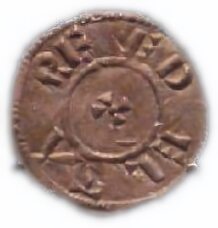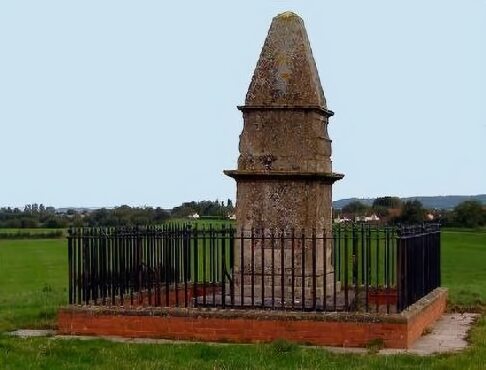King of East Anglia
Guthrum first arrived in England during the great Viking invasion of 865. In 875 the Great Heathen Army army split in two. Part of it, led by Halfdan Ragnarsson, went north, while the other half, led by Guthrum, went into East Anglia and set up base there. By the year 876 Guthrum had acquired various parts of the kingdoms of Mercia and Northumbria and had designs on the kingdom of Wessex, King Alfred the Great.
Coin of Guthrum
In mid-January 878 he invaded Wessex, Alfred confronted him on the south coast. Guthrum sailed his army around Poole Harbour and met with another Viking force which was attacking the area between the Frome and Trent rivers. Guthrum appears to have defeated Alfred in this first battle, taking the castellum as well as the ancient square earthworks known as the Wareham, where there was a convent of nuns.
A peace settlement was negotiated between the two leaders, which was broken by Guthrum in 877 when he led further raids on Wessex, forcing the beleaguered Alfred to confront him in a series of skirmishes that Guthrum won. A further peace treaty was negotiated at Exeter, after which the Vikings left Wessex to spend the winter in Gloucester.
King Alfred Monument
On the Twelfth Night, 6 January 878, Guthrum made a surprise night-time attack on Alfred at his winter fortress at Chippenham in Wiltshire, when he almost succeeded in capturing the Saxon King. Alfred fled the attack with a few retainers and took shelter in the marshes of Somerset, staying in the small village of Athelney. King Alfred had taken refuge for the winter in the Somerset marshes of Athelney, where he spent four months in hiding contemplating how to defeat the Vikings and famously burnt the cakes.
In the Spring of 878, Alfred emerged from his hiding place, determined to defeat the Vikings, he called his loyal followers to Egbert's Stone, and from there they travelled to Ethandun to fight the invaders. The ensuing Battle of Ethandun was fiercely fought and lasted throughout the day, the Saxon forces wore down the Danes. Alfred pursued them back to Chippenham, trapping them in his fortress.
They were besieged by Alfred's forces for two weeks but eventually negotiated a peace treaty known as the Treaty of Wedmore. Under the terms of the treaty, the borders which divided the lands of Alfred and Guthrum were established, Alfred accepted the Danish colonisation of much of England, allowed them self-rule in the area. A line was drawn which ran north-westwards from London to Chester, defining an area north of this line which was termed the Danelaw. This was written as Up the Thames, and then up the Lea, and along the Lea to its source, then in a straight line to Bedford, then up the Ouse to the Watling Street. Guthrum also agreed to convert to Christianity, taking the Christian name Æthelstan, Alfred himself stood as his godfather, accepting him as his adoptive son. The Anglo-Saxon Chronicle records-
'"And three weeks later the king Guthrum came to him, one of thirty of the most honourable men who were in the raiding-army, at Aller - and that is near Athelney - and there the king received him at baptism; and his and his chrism loosing was at Wedmore; and he was 12 days with the king, and he greatly honoured him and his companions with riches."
Guthrum abided by the terms of the Treaty of Wedmore and left the boundary that separated the Danelaw from Anglo-Saxon England unmolested. He withdrew his army from the western borders facing Wessex and moved eastward, eventually settling in East Anglia in 879.
He remained in East Anglia until his death in 890. Guthrum was buried at Headleage, which is thought to be Hadleigh in Suffolk.
Viking Mythology PreviousNext Ragnar Lodbrok
